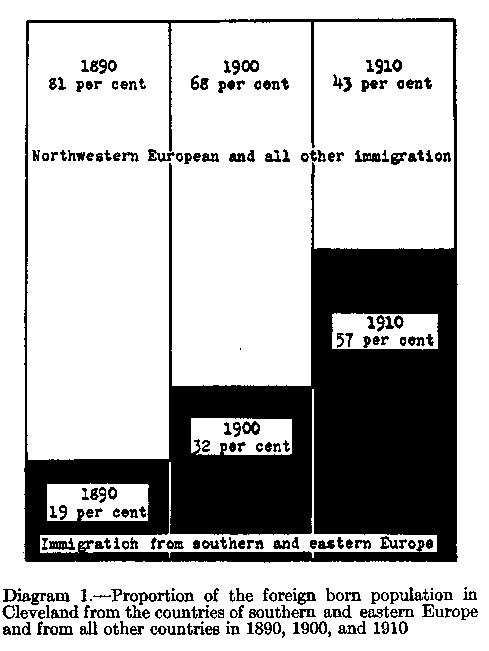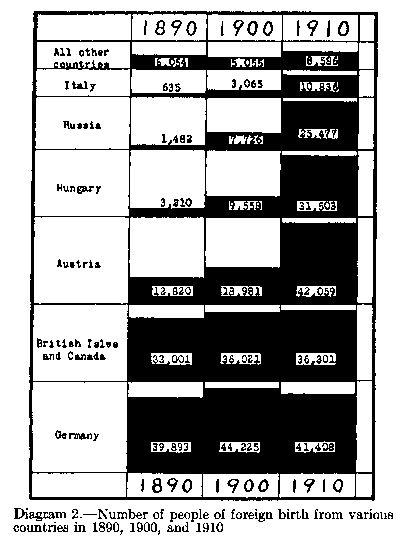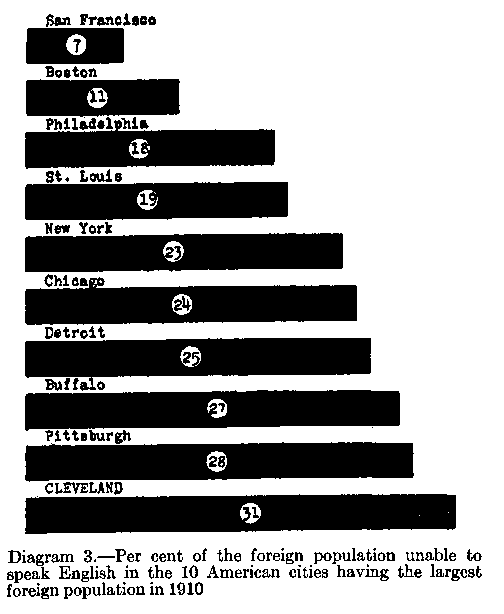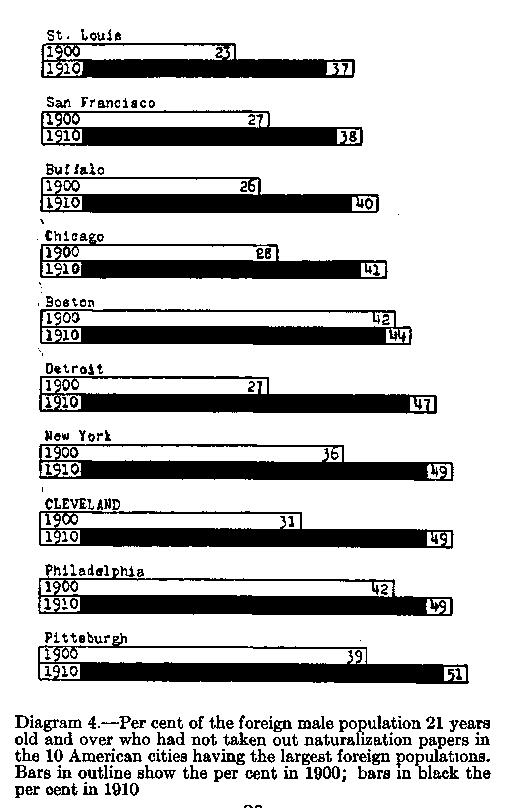The School and the Immigrant
Chapter 1: Cleveland as a Foreign City
Herbert A. Miller
Table of Contents | Next | Previous
Cleveland is one of the most foreign cities in the United States. Of the 50 cities having a population of over 100,000 inhabitants at the time of the last census, only seven—New York, Chicago, Boston, Paterson, Fall River, Lowell, and Bridgeport—contained a larger proportion of foreign inhabitants. Cleveland's foreign population would constitute by itself a city larger than any other in the state of Ohio except Cincinnati, and equalled or surpassed in size by only 28 other cities in the entire country.
The rate of increase in the foreign population has closely followed the general growth of the city. The proportion of foreign born inhabitants to the total population has varied but slightly during the past quarter of a century. When the census of 1890 was taken, 37.5 per cent of the total white population was foreign. In 1910 the proportion had decreased
( 12) to 35.5 per cent, a shift of only two per cent in 20 years.

Although the ratio of foreign to native born has been fairly constant, quite the contrary is
(13) true with respect to the sources from which the foreign element is drawn. In 1890 nearly three-quarters of all the foreign born population of the city were from northern and western Europe, and over one-third were from countries in which the national language is English. During the last two decades of the past century the tide of immigration shifted and there has been an ever-increasing number of immigrants from southern and eastern Europe, while the proportion from English-speaking countries steadily decreased. This change in the composition of the foreign population is shown graphically in Diagram I.
In 1890 there were about 71,000 foreigners in Cleveland from the northern and western European countries. The number increased to approximately 76,000 in the following decade, but from 1900 to 1910 not only was there no increase, but the census shows an actual loss of nearly 2,000, although the whole population of the city nearly doubled during the same period. On the other hand, the number drawn from southern and eastern Europe, which was about 18,000 in 1890, increased during the following two decades over 600 per cent, or more than 13 times as rapidly as the general increase in population, reaching a total in 1910 of nearly 112,000. In 1890 natives of southern and eastern Euro-
(14) -pean countries constituted less than one-fifth of the total foreign population of the city; in 1910 they constituted nearly three-fifths of the total.
The number from each of the principal countries at the end of the three last census periods —1890, 1900, and 1910—is shown in Diagram 2. In 1890 and 1900, Germany led, with the English-speaking countries—the British Isles and Canada—a close second. During the decade 1900-10, the immigration from Austria, Hungary, Russia, and Italy increased at a tremendous rate, so that in 1910 the Austrians led in point of numbers, with a total of 42,059, an increase of 23,078 over 1900. During the same period the number of Hungarians increased from 9,558 to 31,503, the Russians from 7,720 to 25,477, and the Italians from 3,005 to 10,836. Of the 97,000 foreigners in Cleveland in 1890, less than two-thirds came from non-English-speaking countries; in 1910 the proportion had risen to considerably more than four-fifths.
A LARGE PROPORTION CANNOT SPEAK ENGLISH
Without going into a detailed study of the social and educational characteristics of the old and the new immigration, we may take up briefly two points of peculiar significance from the
(15) standpoint of public education. The first relates to the ability to speak English. The successful

assimilation of the immigrant, his adaptation to American customs and ways of thought, and
(16) to a marked degree his economic and social status, depend on his ability to read and speak the English language. Nearly every disadvantage under which he labors during his first years in this country can be traced in the last analysis to ignorance of English.
Cleveland's foreign population is becoming increasingly foreign from the standpoint of ability to read, write, speak, and understand the English language. In 1900 less than one-fifth of the foreigners in the city 10 years old and over were unable to speak English; in 1910 the proportion of non-English-speaking foreigners had risen to nearly one-third of the total.
Diagram 3 shows a comparison of the proportion of the white foreign population 10 years old and over unable to speak English in the 10 cities of the United States having the largest number of foreign inhabitants in 1910. In this comparison Cleveland stands at the foot of the list, with a per cent of 31.3, or nearly one-third. In proportion to its total foreign population there are over one and one-fourth as many unable to speak English as in Chicago, nearly one and two-fifths as many as in New York, and approximately three times as many as in Boston.
There is no obvious explanation of this abnormal situation. It is true that the greater proportion of English and Irish immigrants in
(17) Boston and the heavy immigration from Canada in border cities like Detroit and Buffalo are factors which make for a low proportion of

non-English-speaking inhabitants in those cities. But this explanation does not apply to such cities as New York, Chicago, and St. Louis,
(18) where the proportion of immigrants from English-speaking countries is practically the same as in Cleveland.
New York more closely resembles Cleveland in the distribution of its foreign population with respect to country of birth than any of the other cities compared. The proportion from northwestern Europe is almost exactly the same in both cities; in the proportions from southern and eastern Europe and from English-speaking countries the differences are negligible. It is almost inexplicable in view of the close similarity as to country of birth and language that the relative number of foreign born inhabitants unable to speak English in Cleveland should so greatly outnumber those in New York. The conclusion seems inevitable that the city's low standing as to the number of its foreign inhabitants who were unable to speak English at the time of the last census is not due to such factors as the nationality or mother tongue of the various groups that make up the foreign population.
FEWER BECOME AMERICAN CITIZENS
There are at the present time between 60,000 and 65,000 men in Cleveland who are not citizens of the United States. Of every 100 men of voting age in 1910, approximately 30 possessed
(19) no political rights or interests in this country and owed no allegiance to the government of the United States. In no more important respect does the new immigration from southern and eastern Europe differ from the old immigration from northern and western Europe than in its tendency to cling to an alien political status and indifference to the privileges and duties of American citizenship.
In recent years there has been a marked change for the worse in this respect throughout the entire country, but in few of the larger cities has the downward trend been more pronounced than in Cleveland. Of the 10 American cities having the largest foreign population in 1910, only two — Philadelphia and Pittsburgh— showed a higher proportion of foreign men who had taken no steps to obtain American citizenship. In 1900 the proportion of foreign born males 21 years old or over who were naturalized or had taken out their first naturalization papers in Cleveland was 69 per cent; in 1910 it had dropped to a little over 51 per cent. This falling off in the percentage of naturalization was exceeded only in Detroit among the 10 cities. The per cent in each city who in 1910 had taken no steps toward securing American citizenship is shown graphically in Diagram 4, with a corresponding comparison for 1900. In every case
( 20)

(21) the figures show a decrease in the proportion of naturalization although the amount of variation between the two census periods differs widely. St. Louis leads with 37 per cent, Pittsburgh ranking lowest with 51. Cleveland, which ranks eighth among the 10 cities, shows only a slightly smaller percentage of naturalization than New York, but a much greater loss for the decade.
The present standing of the city in this particular is less disquieting than the marked retrogressive trend the data reveal. The fact that the social and political assimilation of the great mass of aliens in the city is proceeding at a steadily decreasing pace is of the gravest import in its relation to the future welfare of the city.
SUMMARY
Cleveland is one of the most foreign cities in the United States. The proportion of foreign-born has varied but slightly during the past 25 years, but the proportion of foreign inhabitants from the countries of southern and eastern Europe has increased very rapidly, while that from northern and western Europe shows a marked decrease.
The foreign population has become increasingly foreign from the standpoint of ability to
(22) speak and read the English language. In none of the 10 cities having the largest number of foreign inhabitants at the time of the last census was the proportion unable to speak English so large as in Cleveland.
In 1910 nearly one-third of all the men of voting age in Cleveland were aliens, possessing no political rights in this country and owing no allegiance to the government of the United States. Conditions in this respect are worse in Cleveland than in most of the larger cities of the country.